Bitcoin is very secure: the fear of reduced block rewards is exaggerated
The copyright of this article belongs to the original author, only represents the author's own point of view, does not represent the views or positions of the credit letter or the credit research institute. This article is about 9,500 words, and it takes about 20 minutes to read the full text.
Too long to read the version – This article comprehensively discusses concerns about the Bitcoin security model, which is funded by block subsidies and transaction fees. key point:
- The more the Bitcoin network develops, the safer it becomes.
- In the long run, there will be organic security trade-offs between block subsidies and transaction fees. As the network effect increases, the demand for block space increases, thus reducing the need for block subsidies. We have empirical evidence that this is happening and that future forecasts look optimistic.
- Bitcoin's block space is a scarce and unique commodity. It will continue to accumulate demand.
- The bull market in 2017 was not due to the sudden use of blockchains by millions of users to transfer funds globally and to minimize transaction costs, exchange costs, volatility costs and coordination costs.
- The price elasticity of Bitcoin traders is high. Even in an environment with high transaction fees, the demand for Bitcoin block space will increase.
Block reward
About every 10 minutes, a new Bitcoin block is created that contains the newly minted bitcoin ("block subsidy") and the transaction (which includes the transaction fee paid by the entity that sent the transaction). The value of the newly minted coin plus the transaction fee is called the “block reward”.
- Talking about Bitcoin Investment from the Perspective of Large-Scale Asset Allocation
- The Brazilian exchange was sued for $13 million and the CEO was exposed to 25,000 BTC
- This time, Bitcoin is a safe-haven asset.
According to the monetary policy written in Bitcoin code, the amount of newly minted coins in each block will decrease over time, eventually reaching 0% in 2140 (also known as the de-inflation model). At the time of this article, more than 83% of all bitcoins that will exist have been cast, and the current annual inflation rate is only 3.8%. By 2040, more than 99% of Bitcoin will be dug up.
“In fact, no one can act as a central bank or federal reserve to adjust the money supply as the number of users grows. That would require a trusted party to determine value because I don’t know how to let the software know the true value of the various items. If there is some clever way, or if we want to trust someone to actively manage the money supply and link it to something, then we can make rules for this." – Nakamoto Satoshi
Nakamoto believes that it is impossible to set a "appropriate" inflation rate (due to local knowledge problem), and this introduces a political attack, so he decided to remove artificial decisions from the process. Every time a monetary policy is changed or modified, human governance re-enters the system, thereby invalidating the certainty of the money supply. This ultimately leads to a reduction in social scalability, which increases the risk of fragmentation and divergence. Predictable monetary policy is key: Bitcoin's focus on long-term stability and transparency creates confidence for investors and developers.
In other words, the fixed monetary policy in Bitcoin effectively and directly solves the property rights problem: there is no hard supply cap, and the share of all future stocks owned by any particular holder becomes uncertain; The supply policy almost always dilutes the individual's share of the currency over time. Because the supply cap solves the property issue, the value of these currencies tends to increase.
I won't spend more time studying Bitcoin's monetary policy because I think it's a separate topic and I need a special article (I'll post it in the next few months).
So why is this important? Block incentives encourage miners to protect the network. As the inflation rate approaches zero, miners will increasingly receive income only from transaction fees. Some people worry that the miners cannot provide enough compensation for the miners alone. Security and trust are critical when storing large amounts of wealth.
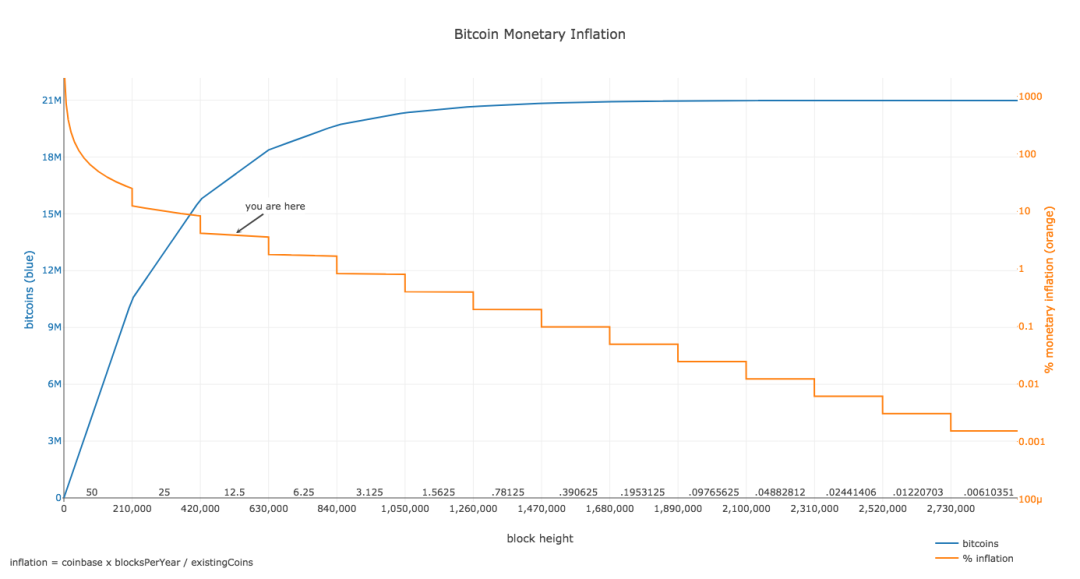
https://plot.ly/~BashCo/5.embed?share_key=ljQVkaTiHXjX2W41UiqzCnCreated by BashCo
Bitcoin security model
“After a few decades, when the rewards become negligible, the transaction fee will become the main compensation for [miners].” – Nakamoto Satoshi
Bitcoin's existing UTXO set (book) and new block are protected by game theory and physics. Bitcoin uses Workload Proof (PoW) to make changes to the reconciliation book difficult, which eliminates trust and introduces external costs for any possible attacker. Miners buy hardware (capital expenditures) and electricity (operating expenses) and expect to receive some of their block rewards based on the amount of work they spend (hash). Block rewards have economically inspired the behavior of miners.
As the price of bitcoin rises, the value of block rewards also increases, which motivates miners to put more computing power on the line. The higher the power of a cryptocurrency network, the higher the cost of attacking 51%.
A secure budget protects the network from 51% attacks, which occurs primarily at the tip of the blockchain rather than the entire chain rewrite, which will require much more resources.
In the early stages of the network, block subsidies were more rewarding for bitcoin miners than transaction fees. With Bitcoin's deflationary monetary policy, block subsidies fall by about 50% every four years. This creates both volatility and price increases: if demand remains the same (or increases), a reduction in supply means that demand is chasing fewer new cast bitcoins that are placed on the market. This influence has brought new speculators as part of the beauty of their design, as supply shocks have given Bitcoin greater visibility.
“As the number of users increases, the value of each currency increases. It has the potential to generate a positive feedback loop; as users increase, so does the value, which may attract more users to take advantage of the growing value.” — —Zhong Bencong

Although the two represent the same security budget, block subsidies and transaction fees are quite different. For block subsidies, the value can be used both as a reasonable way to issue new bitcoin and as a viral FOMO cycle built into the agreement, thereby increasing the number and network effects of Bitcoin believers. It further stretches the need to provide security only by transaction fees. So this is why it is called a “subsidy”.
In the long run, there will be organic trade-offs: as the network effect increases, the demand for block space increases, thereby reducing the need for block subsidies. Although we don't know why Nakamoto has chosen this release schedule for Bitcoin, we can speculate. The interval between two halvings is a long planning and construction time. For a similar length of time, we gave the President of the United States four years to let him achieve planning for the entire country.
Through the model completed by Awe and Wonder (https://twitter.com/Awe_andWonder), we can see that around 2030, the transaction fee will always represent a healthy part of the block reward. When transaction fees account for more than 50% of the block awards in the long-term (by year), Bitcoin will evolve to rely more on transaction fees to survive.
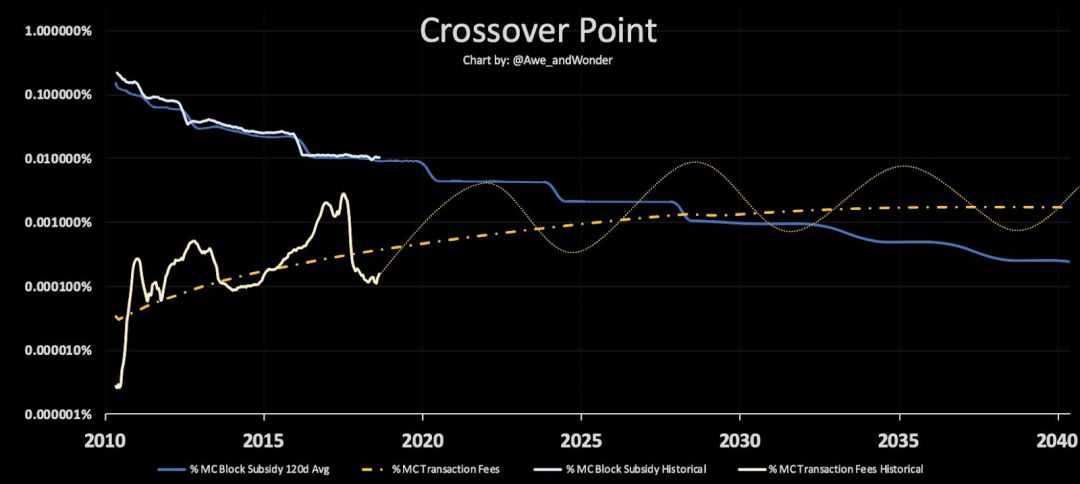
Awe and Wonder's charts and forecasts. The Y-axis is a percentage of the daily market value of Bitcoin.
Critics often claim that transaction fees alone do not provide sufficient security. But what is the appropriate level of security? This is very subjective because the number of confirmations waiting depends on the size of the transaction and the health of the network. However, despite subjectivity, we should still try to calculate. At the MIT Bitcoin Conference, Nic Carter (https://twitter.com/nic__carter/status/1104922151247859712) presented several ways we can quantify the appropriate security budget:
Threshold : Bitcoin is considered safe at a given level of security spending
Stock : Security spending should be tied to the value of Bitcoin itself
Increment : Transaction fee must be large relative to transaction volume
I personally think it's best to measure security with a percentage of the stock that eventually reaches the threshold level. Stocks are more meaningful than incrementals, as miners will increasingly focus on long-term operations as ASIC efficiency decreases. In the end, this has reached a threshold level, and even the richest countries are hard to break.
I assume that hundreds of billions of dollars (in current dollars) will be a sufficient security budget because it is difficult for the government to prove that it is a waste of so much money to attack the tip of the Bitcoin blockchain. They must also respond publicly to such attacks because their citizens (taxpayers), businesses and banks will invest in Bitcoin.
Please note that 51% of attacks will not "kill" Bitcoin, because you still can't easily undo historical transactions, here (http://bitcoin.sipa.be/) calculates its workload.
“This may also increase the value of the transaction fee market, as the demand for mobile bitcoin should increase, creating more incentives for non-attackers to market the service transaction fee” – Neil Woodfin
Finally, in the absolute worst case of a sustained 51% attack, what must be retained is the UTXO set (book). If you have to give up SHA256, then that's it. In that case, Bitcoin can use another mining algorithm that already has a mature market, thereby invalidating all state-level mining equipment. I want to make it clear that this will be the last effort and there is no guarantee that it will succeed, but the simple fact that this may happen may prevent a country from trying to conduct such an attack.
It's important to note that PoW not only minimizes 51% of attacks, but also improves network effects. It also achieves other goals while ensuring that the cost of creating money can prove to be expensive (unforgeable costs). .
There is no room for quality property
Allowing a transaction to be dug up can be considered as purchasing a portion of the block. By analogy, a fixed amount of land is generated every 10 minutes on average, and people want to bid for the land through transactions. Even in a zero-inflation environment, the sale of this land can provide support for miners. The price of this land is determined by the trading needs, as the supply is fixed and known. The basic premise is that if the network is being used/valued, it will reward the miner for verifying/protecting the network.
Some people think that the altcoin block space is an equivalent substitute. However, we can debunk the theory in many ways. Bitcoin real estate is a quality property (for example: the cheap land of Midland, Texas is not important, it will never have San Francisco scenery or social networks, so demand will be reduced). The unique value of Bitcoin block space is in terms of security costs , switching costs , volatility costs, and coordination costs.
The following section borrows heavily from Donald McIntyre's article "Observation of Paul Sztorc's Bitcoin (Long-Term Security Budget) Essay ( https://etherplan.com/2019) /05/17/observations-about-paul-sztorcs-bitcoin-security-budget-in-the-long-run-essay/7587/ , he allowed me to use a lot of direct quoted chapters without quotes so that the article could have more Great coherence)
Security costs: Bitcoin is the safest cryptocurrency network due to accumulated total power (energy). This will create a market for Bitcoin's high-value, highly secure transfers, such as central banks, governments, interbanks, companies and other large payment users, who will be willing to pay very high fees. There is also a safety feedback loop because other chains borrow the strong security of Bitcoin by doing chain trading, as we have seen on Veriblock recently.
Transaction Cost: When senders and receivers want to use Bitcoin to store value, but need to transfer them, "from Bitcoin to Ark, send it at a lower transaction fee, then transfer it back to the other end. There is friction in the coin. There will be no difference between the trading commission (0.1–4%), the spread (due to the poor liquidity of the altcoin) and the transaction fees of the two methods. It is better to pay the bitcoin transaction fee beyond this point. If Bitcoin is a very good value store, then for the same reason that Bitcoin is a good value store, the transfer will happen inside Bitcoin.
Fluctuation costs: Usually people forget to consider the cost of volatility, which depends on your holding period . Altcoins usually have higher volatility than bitcoin, and volatility has an annoying effect that expands with the size of the transaction. A hypothetical example:
Litecoin: $10 payment x 10% amount + 0.01 transaction fee = $1.01
Bitcoin: $10 payment x 1% quantity + 0.20 transaction fee = $0.30
Litecoin: $100 payment x 10% amount + 0.05 transaction fee = $10.05
Bitcoin: $100 payment x 1% quantity + 1.00 transaction fee = $2.00
Assume that the bitcoin transaction fee has increased by a factor of five, but the volatility loss of Litecoin has caused the transaction fee to be about $10! On the contrary, even if you make money through volatility, you still have to pay capital gains. The chart below shows the average cost and volatility of Bitcoin, Litecoin and Ethereum. Unfortunately, it is difficult to calculate the average cost of volatility without the average individual holding period for multiple currencies.

Coordination costs: not all currencies can survive. There will be a limited competitive block space market worldwide. This is because our thinking is limited, we will not consider 250 cryptocurrency names, transfer fees, subsequent 250 prices, and choose the cheapest one (@NickSzabo4) for each transfer value. Our brains can only support the understanding of the value of 2 or 3 coins, and they can be used interchangeably to some extent (although there are very weak/unverified possibilities in a large amount of currency after the appropriate user experience/user interface). deal with). In addition, since Bitcoin coins have a strong affinity (monotheistic) for trading in Bitcoin, multiple currency holders will be forced to trade in Bitcoin (a few tyranny). For example: Square, Bakkt, and Fidelity currently only support Bitcoin.
Ultimately, the Bitcoin core software has been proven in a mature ecosystem. This adds to the value of Bitcoin's unique block space as there are more developers and businesses reviewing and relying on Bitcoin code.
"Bitcoin is money. Multi-currency is barter." – Conner Brown
With all of these factors in mind, the number of currencies in the future will be limited, and block space and trading capacity will be limited. This means that the cost of value transfer will be distributed among the remaining chains based on value and security requirements. But in the end, each altcoin offers a lower security model with higher risk.
“If a chain is by far the safest chain, why do most wealth and valuable applications use it to ensure security? As more users buy safer chains, their buying pressure will push up prices. This will lead to increased security. From there, the ultimate use, mobility and network work will overlap each other. Then, these most valuable and secure chains should be used to protect the richest and most valuable dapp. The expansion of the gender gap, the security model is the same as the more expensive similar products, and the lower value blockchain will become less and less. The side chain, the second layer system, etc. will make the "differentiation characteristics" of the chain become more and more The less important." – Alex Sunnarborg
“In the last bull market, the sudden increase in altcoin and ICO was a race to mimic the wealth creation that took place on Bitcoin. Not millions of people suddenly used blockchains to transfer funds around the world and tried to reduce them. In other words, the coincidence of the altcoin and ICO surge with the 2017 encryption bubble is a common gold rush (we all try to find gold/value stores), but not through a transaction fee to make a rational block space. Dynamic pricing and arbitrage." – Donald McIntyre
Although I don't have enough data to support this (and it's very subjective), I think a lot of the payments are for early adopters. Paying with cryptocurrency is more difficult, more expensive, and slower than traditional payment methods. After all, the basic layer of Bitcoin is to build the most solid foundation for the new global monetary system, rather than creating another Venmo.
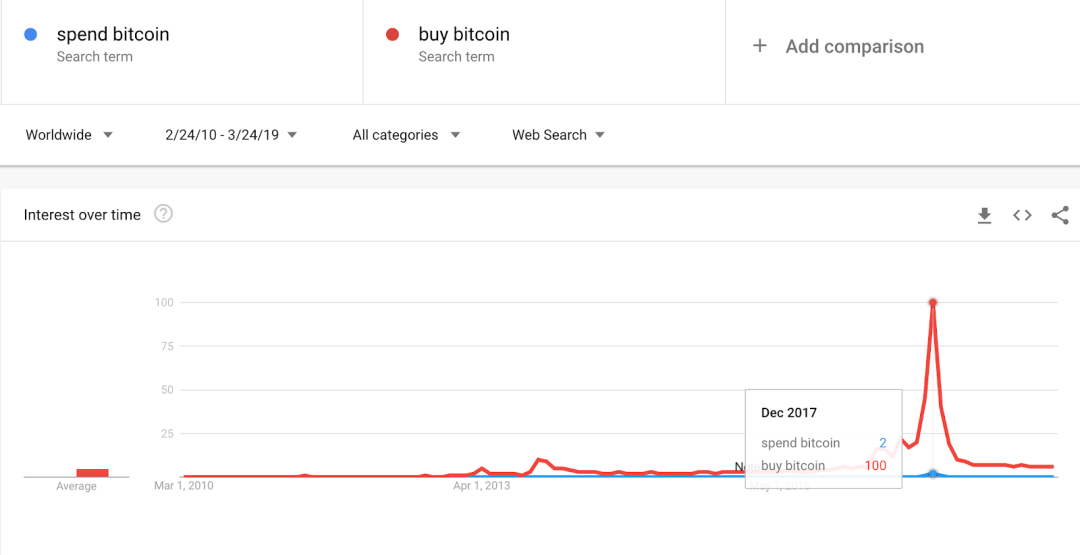 (If I query "bitcoin", we can even see "spend bitcoin" on the graph)
(If I query "bitcoin", we can even see "spend bitcoin" on the graph)
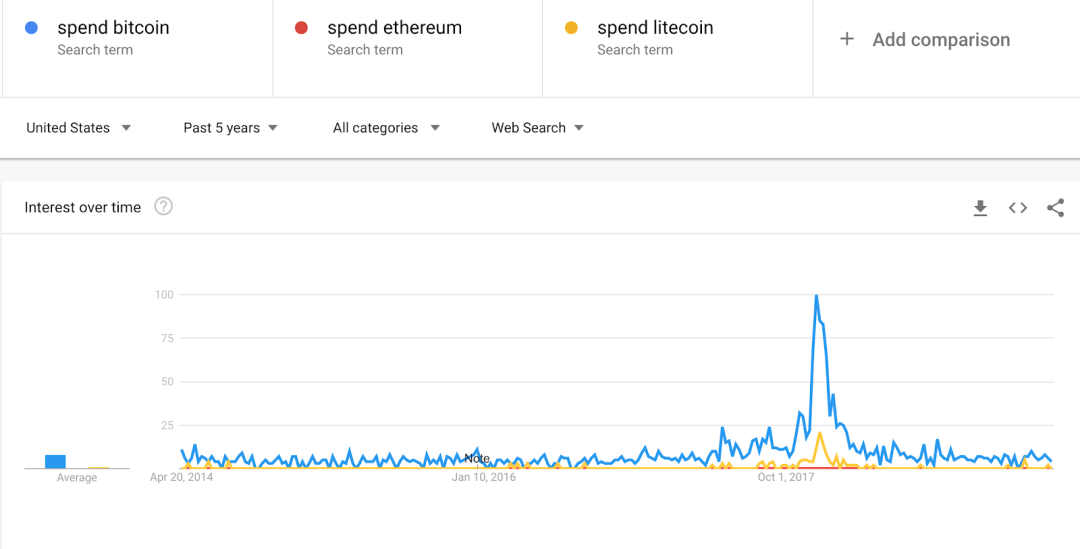
(Users don't want to buy goods in any cryptocurrency, otherwise we will see an upward trend despite price fluctuations)
“I am sure that after 20 years, the trading volume may be very large or not at all.”——Zhong Bencong
Another concern is that as transaction fees increase, users will avoid transactions to avoid transaction fees. However, from experience, this is not the case: as the volume of transactions/transactions increases, transaction fees also increase.

(logarithm)
Price elasticity
"No one is going there again. It's too crowded." – Yogi Berra
Consider the user experience of most North American, European, and Asian consumers/enterprises (most cryptocurrency participants). In most cases, any transaction fee is more frictional than the existing payment method, so any fee is considered "expensive" (as opposed to cash or credit card).
“Think of the cost as insurance. You pay for the safety.” – Ari Paul
The price elasticity of Bitcoin traders (for trading fees) is largely due to the nature of the type of payment sent (constant value store). During the 2017 maximum congestion point, the median transaction fee was $38. During this period, we briefly saw some blocks with higher transaction fees than subsidies. We can compare the cost of the transaction value store to compare:
Wire transfer currency
For US banks, the average domestic wire transfer cost is $30–40 , and international is $65–80 (including the sum of remittance and remittance costs).
Offshore (7 trillion USD market)
" The start-up fee for opening an offshore bank account is between $1,935 and $3,745 [ bank accounts and physical documents]" – Introduction to offshore banking
Real estate (250 trillion US dollars market)
“ Between April 2017 and March 2018, buyers from China purchased 40,400 suites for a total of $30.4 billion. The median cost per purchase was $439,100 ” – National Association of Realtors
The average settlement cost of a home is 2% of the value, which is $8,000. I'm sure that in the future, individuals will be happy to spend $50 to pay for an immutable asset that cannot be easily taken away from them (unlike real estate, where real estate is easily taken away in geopolitical disputes).
Physical gold delivery ($7.5 trillion market)
Donald McIntyre requested information from the German Federal Bank (Bundesbank) about its transfer of 300 metric tons of New York Federal Reserve gold from New York City to Frankfurt (then $12 billion). It took three years to spend $4.8 million.
Smaller gold delivery may require insurance, proven shipping or physical protection during pickup/delivery. Estimated at least about $10-$100.
Increase transaction density
In his MIT presentation, Nick Carter highlighted two ways to increase trading demand: increasing the economic density of the transaction or the semantic density. Semantic density is about letting other blockchains (such as Veriblock) embed their data into the bitcoin blockchain. Economic density is about increasing the types of transactions on Tier 1 and the types of transactions are as follows:
privacy
“Schnorr can create new transaction types, breaking the heuristics that are widely used in blockchain analysis, and it is almost impossible to identify specific entities by simply looking at the blockchain, while increasing each zone by aggregating signatures. Block trading density." – Lucas Nuzzi
Layer 2 (eg lightning network)
With the expansion of Bitcoin (Schnorr on Tier 1, the lightning network on Tier 2, etc.), it will become more efficient, driving higher chain usage. Jevon's Paradox intuitively predicts this – as cars become more fuel efficient, the miles traveled each year increases. Tier 2 will support a large number of cheap small transactions, while Tier 1 represents the more expensive settlement layer for larger transactions (container ships and cargo containers – Nick Carter). The Lightning Network increases the cost of the chain by increasing the utility of txn on each chain (by allowing each txn to do a lot of txn work) and thus making the end user more tolerant of high chain costs.
Since enterprises and Lapps are built around lightning networks, a large part of their operating expenses will be channel management. As these operators rebalance the channels and optimize connectivity and capacity, this will ensure continued demand for Tier 1 settlements. In the chain, the block space is very valuable, so the transaction is charged for the space occupied by the registration transfer. Under the chain, liquidity is invaluable, so the transaction is charged for the number of transfers through the channel (because it needs to be rebalanced). In other words, chain trading and chain trading have complementary different charging models. In the chain, regardless of the value of the transaction, the transaction fee is constant, and under the chain, the transaction fee is priced as a percentage of the value transfer. There is an intersection where it is more expensive to use high-value transactions on the lightning network than to use the first layer.
We have seen evidence that even though the lightning network is still in a highly experimental form, it is increasing the use of Tier 1 . There is a block created in February 2019 (https://blockstream.info/block/0000000000000000001ed7962d1df5909bbdc881e382314499b8070eaaf485e7), of which 25% of the blocks are lightning network transactions that open channels. This is detectable because the Lightning Network uses a malleable patch of quarantine witnesses, and all open lightning network channels are isolated witness transactions. *
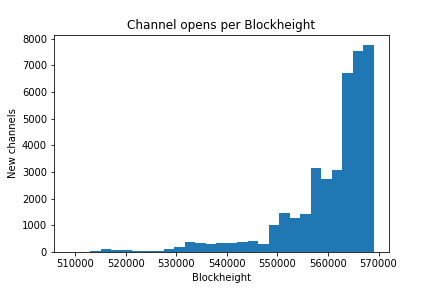
"The nodes in the lightning network will disseminate information about which (public) channels exist in the network, including references to the funds tx, which we will check to ensure that the announcement is true. This is also underestimated because There are also some private/unpublished channels." – Snyke
Anti-quantum
“Using anti-quantum technology will also lead to larger (and more expensive) transactions. Post-quantum encryption algorithms require a larger key size, which in turn increases the size of non-witness data in transactions.” – Lucas · Nuzi
overall
We have empirical evidence that in the next few decades, total fee income will slowly become equal to block subsidies. Based on these data, concerns that transaction fees are not a substitute for block subsidies are ultimately exaggerated.
The chart below shows the percentage of transaction fees as a percentage of block subsidies.
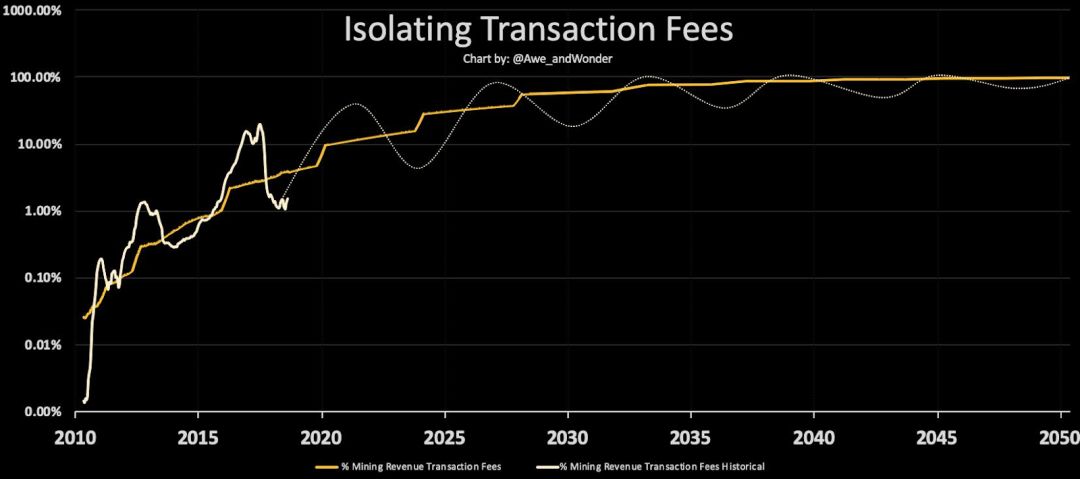
Awe and Wonder's charts and forecasts. The Y-axis is the percentage of transaction fees that are covered by the block.
As Alex Saulberg pointed out, only Bitcoin and Ethereum have enough meaningful transaction fees to compensate miners in an environment without inflation. Any other network is unlikely to compete.
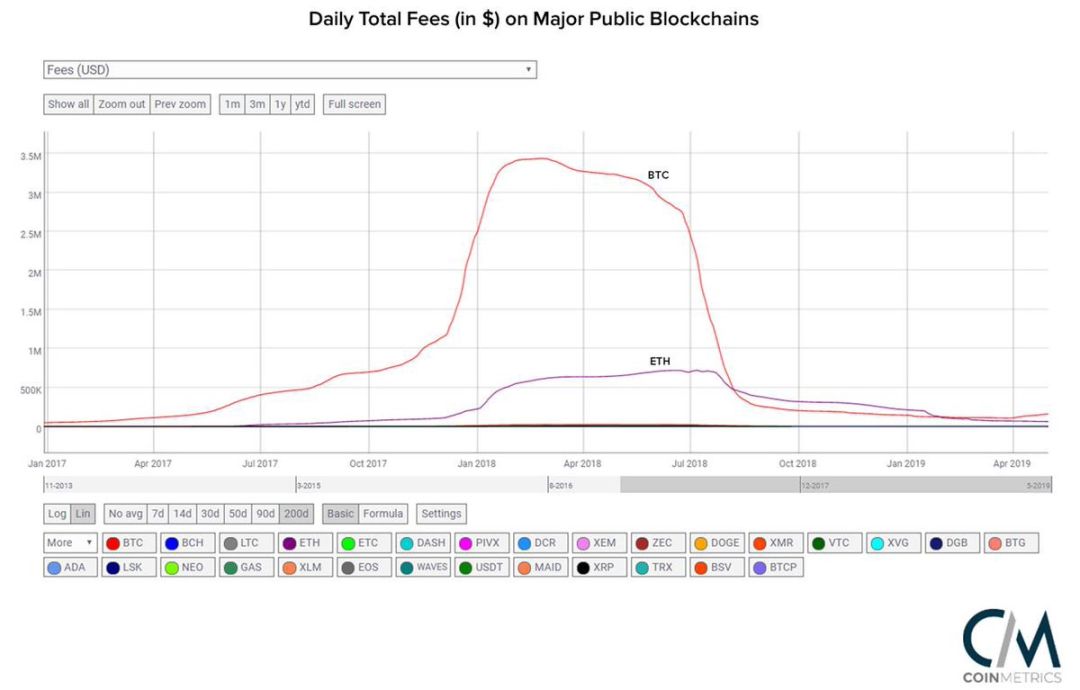
Data from CoinMetrics, the chart was originally compiled by Alex Saarberg
“The volatility of transaction fees seems to be non-linear as the block becomes full. It may lead to corresponding large fluctuations in computing power.” – Nick Saab
Scarce block space is a good thing, as we will see a large backlog of transactions, which indicates the future intention of rewarding miners, thus stabilizing the system. The 2017 blockage proves that the system can create and maintain a backlog of orders.
A reasonable concern is that cash flow will fluctuate in the pure transaction cost guarantee model. Trading fees are market-centric, which means they will fluctuate depending on supply and demand. The basic assumption is that the cash flow generated by the transaction fee will be unstable, which will reduce the security of the network. Dan Mcardle summed up this very well:
“As mining becomes highly commoditized with the participation of mature companies, miners are less likely to play short-term games, preferring to continually mine. Further, miners may be perpendicular to other services (eg, over-the-counter) Integration, which becomes an additional profit center (which means they are not too worried about possible participation in the game piece by piece)" – Dan McCarder
Miners like steady cash flow, which is why they join the pool. Instead of playing short-term games, they try to win blocks, but instead win the group.
In the worst case, the mining fee is unstable and does not actually damage the system. It only extends the settlement time until the transaction fee increases enough to allow the mining to start again. For the sake of time preference, the entity will increase the transaction fee to deal with and counterattack.
Moreover, in the past few years, the actual value of subsidies has become extremely unstable, while the mining industry remains strong and stable, even if the subsidy value has shrunk by 80%. This “unstable” does not affect the network. As the market matures, the mining industry will become more resilient to greater volatility.
In the future, miners may auction space in future blocks ahead of time, which may stabilize their income (the same way farmers sell crop futures). The basic premise is that if the use of Bitcoin increases, the free market for future block spaces will be properly priced.
Finally, if this is a major problem that the market cannot solve naturally, then we can make some minor changes in the agreement to smooth the fee income. However, this will make the basic agreement more complicated, and we have not fully explored the game theory behind it. E.g:
“Other long-term low-subsidy era ideas include the use of cross-block interval average transaction fees to smooth transaction fee income.” – Adam Back
What is the transaction fee in the post-subsidy world? I built a model that would help us think carefully about what they might be like in 2140 (in today's dollars) and provide some necessary assumptions that you can look at below. In the most crowded state of 2140, the cost of Tier 1 transactions may be only $8-$82, depending on the market value of Bitcoin. For most consumers, trading at Tier 1 is rare, just like wire transfers.
10 trillion market value
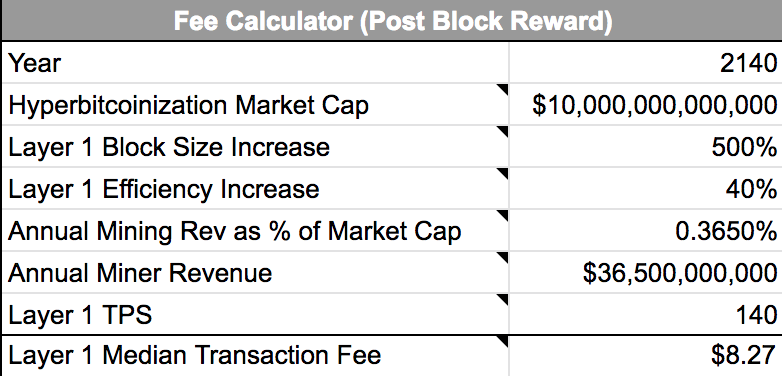
If you want to insert your own assumptions, you can try it out here (https://docs.google.com/spreadsheets/d/14oX1RUpnvQcc44zcAyumYNmJrDvGzcsPEeEJ0wIyNJI/edit?usp=sharing).
10 trillion market value
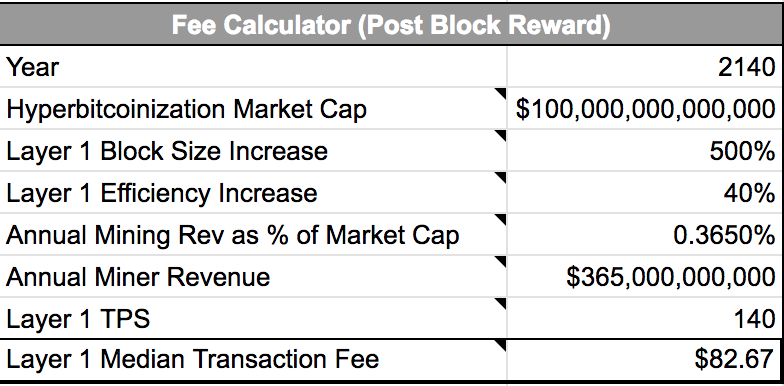
If you want to insert your own assumptions, you can try it out here (https://docs.google.com/spreadsheets/d/14oX1RUpnvQcc44zcAyumYNmJrDvGzcsPEeEJ0wIyNJI/edit?usp=sharing).
Assumptions
Hyperbitcoinization
As in the past decade, Bitcoin has survived and thrived and continues to grow its market share at an exponential rate. I chose Bitcoin's maximum market capitalization in the value of super bitcoin to be $10 trillion (worth slightly higher than gold) and $100 trillion between dollars, which is a general estimate for bulls. To look at this value correctly:
Total global wealth: $750 trillion
Real estate: $225 trillion
French currency: 50 trillion US dollars – 100 trillion US dollars
Gold: $7.5 trillion
Block size
Block size is constrained by latency, bandwidth, and storage. If you don't fundamentally change the way packet routing works, or if you don't increase the speed of the delay, then choosing growth rates based solely on bandwidth or storage increases is not the right choice (another consideration for latency is Tor's availability). ). Let's take a look at the overall problem of larger block sizes.
Of course, larger block sizes can alleviate some of the apparent cost pressures of traders (thus reducing public censorship of informant critics and reducing the "cost" of traders). However, this has changed the cost of the node operator while reducing the decentralization in some way, and decentralization is something that first makes Bitcoin valuable. Moreover, this exacerbates the centralization of the mine pool. The degree of centralization allowed is a constant debate in the Bitcoin community.
There is a market mechanism that can compensate node operators. For example: encourage relay, transaction data, service level agreements, etc. However, at present, this is basically only theoretical.
If you decide to increase the block size, its growth rate should decrease (similar to Bitcoin's inflation rate). Otherwise, we will have to agree to a softer fork in the future with a smaller limit, which is exactly the opposite of what we want. Some studies have shown that 8MB may be the largest block size without harmful effects.
Finally, some discussion has been made around reducing block time, which will provide the ability to further increase the block size.
Tier 1 efficiency
With the Schnorr signature (coming soon), it is estimated that this upgrade will reduce storage and bandwidth usage by at least 25%. We can assume that there will be some additional efficiency gains in the next 120 years (Taprooft/Graftroof in the near future).
In the chart below, we can see that in the next decade, the percentage of transaction fees to market value will tend to be slightly higher than 0.001% per day. Even as block subsidies continue to decline, as bitcoin gets more adopted, total mining revenue (ie, safety) increases exponentially.
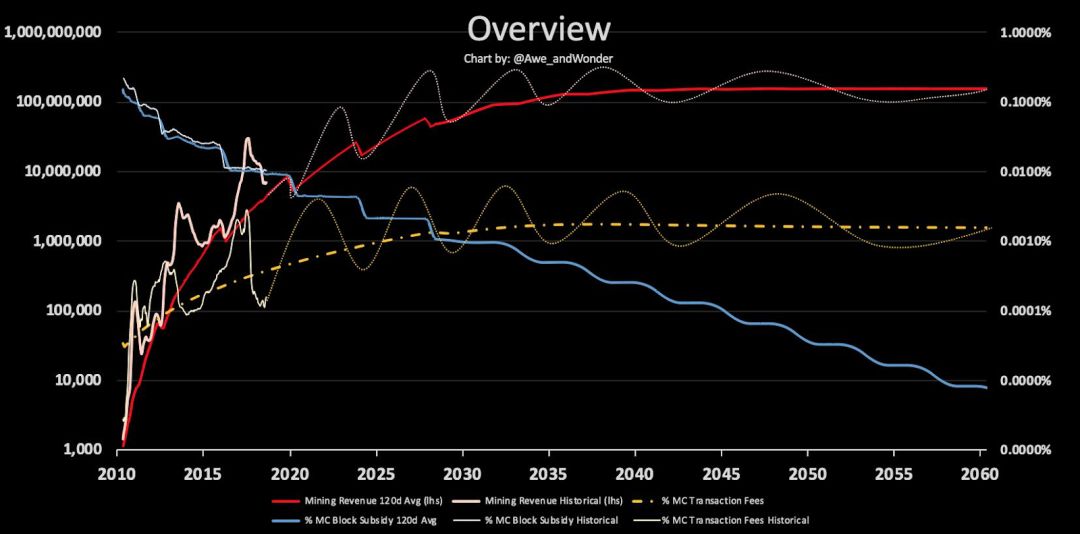
Awe and Wonder's charts and forecasts. The left Y-axis is the daily mining income of the US dollar. The Y-axis on the right is the transaction fee/block subsidy, which is a percentage of the market value.
TPS
Assume that in the case of a segregated witness, the current Tier 1 is a maximum of 20 TPS. TPS depends on the byte size of the transaction, but I have to choose a value to build the model.
Defective potential solution
Suggestions for adding 21 million hardtops or "unlocking" dormant coins are not recommended at this stage for three reasons:
- Lack of evidence that declining block subsidies will be a problem
- Because of their moral trade-offs, such demands can cause disagreements.
- If a problem does not appear until at least ten years from now, a more acceptable fix will occur
I explained what the security level is, the main (and non-replicable) block space of Bitcoin, the transaction requirements, what happens after the subsidy is used up, and security and stability. We have empirical evidence that appropriate security budget financing will be balanced by transaction fees. The trade-offs are always between inflation (block subsidies) and transaction fees, while Bitcoin is at the position where the transaction fees are most reliably charged. If there is no economic (transaction) amount in a decade, Bitcoin will fail anyway.
Most of the most critics criticize the absurd assumptions in their models to predict failure and pessimism. Instead, cyberpunks speak in code.
Nakamoto is essentially a scholar who writes production code and publishes work models in the environment. The model first focuses on practical meaning.
Despite the fierce hostile environment, his experimental bitcoin has been running for 10 years – all the data shows that we have reason to believe that it will continue to thrive.
– The End –
Text: Dan Held
This article was compiled by the Credit Research Institute. The original link: https://blog.picks.co/bitcoins-security-is-fine-93391d9b61a8
We will continue to update Blocking; if you have any questions or suggestions, please contact us!
Was this article helpful?
93 out of 132 found this helpful
Related articles
- Video: Those Internet companies that are surpassed by the market value of Bitcoin
- Bakkt is finally on the line, industry insiders said: In the long run, it is conducive to the development of cryptocurrency
- Bitcoin computing power broke the first hundred EH/s, gold mining is at the time?
- Nic Carter: Bitcoin's currency experiment
- The Chicago Mercantile Exchange will launch bitcoin options in the first quarter of 2020
- CF Benchmarks, a company that provides Bitcoin index services to CME Group, licensed by the UK FCA
- Blockchain event review | BTC and gold trend are now different, digital gold crown is not guaranteed?





